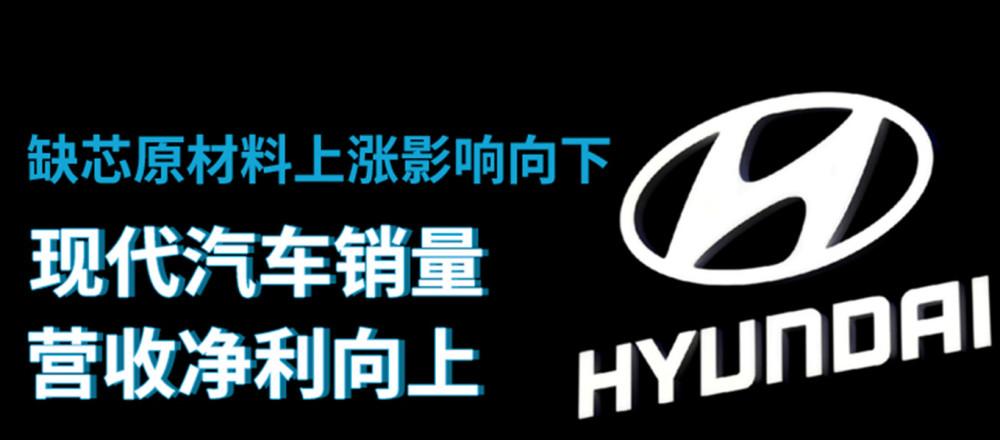
Auto-First | Liu Tianming
Affected by the epidemic, chip shortages, rising raw material costs and low base effects, Hyundai Motor handed over an annual report card with rising performance and sales.
According to Hyundai Motor's 2021 results released on January 25, the cumulative sales volume for the whole year reached 3.8907 million units, an increase of 3.9% over the same period last year, the operating income reached 117.6 trillion won, an increase of 13.1% over 2020, and the net profit rose 195.8% from the same period last year to 5.7 trillion won.
In the fourth quarter, Hyundai Motor did not increase revenue. In terms of sales, Hyundai Motor's global sales in the fourth quarter were 960,600 units, down 15.7% year-on-year, and revenue increased by 6.1% year-on-year to 31 trillion won. Due to one-time expenses related to employee bonuses and the continuous rise in raw material costs, the increase in revenue did not bring Hyundai's net profit to an increase, and the fourth quarter net profit fell by 40.7% from the same period last year to 701.4 billion won.
In response to declining sales but revenue growth, Hyundai motor pointed out that although the unfavorable economic environment has slowed sales, sales of SUVs, GENESIS and electric vehicles have continued to rise, making the fourth quarter revenue show a growth trend.
It is worth noting that Hyundai motor has not completed its 2021 sales target. According to Auto-First, at the beginning of 2021, Hyundai Motor set a sales record of 4.16 million units for the whole year, and in October, due to the shortage of chips and parts, the factory stopped production, and Hyundai Motor lowered its sales target of 4.16 million units to 4 million units. Even after the downward revision, sales in the Korean domestic market and the Chinese market declined, making it nearly 110,000 vehicles different from the sales target, and the sales target was 97.3%.
In the Korean market, Hyundai Motor's cumulative sales for the full year fell from 788,000 units in 2020 to 727,000 units, a year-on-year decline of 7.74%. Hyundai's sales in the Chinese market were not outstanding, with full-year sales of only 359,000 units, down 18.4% from the cumulative sales of 440,000 units in 2020.
However, Hyundai motor has performed well in the North American market, the Indian market, the European market and the South American market. Among them, Hyundai Motor's cumulative sales in the North American market were 825,000 units, an increase of 1.6% over the same period last year. The Growth rate of the Indian market was significant and exceeded the sales target, with cumulative sales reaching 511,000 units in the whole year, an increase of 20.52% year-on-year. Cumulative sales in the European market for the full year were 537,000 units, up 18.28% year-on-year. In addition, Hyundai Motor maintained positive sales growth in Asia Pacific, the Middle East and Africa, Russia and other markets.
Hyundai's sales in the Chinese market showed a downward trend, but its joint venture in China, Beijing Hyundai, has completed the deep ploughing and renewal of the whole system. According to Auto-First, in 2021, Beijing Hyundai will promote enterprise transformation and brand upgrading around multiple dimensions such as product layout, technology application, marketing innovation, and service upgrades, and the brand image of modern technology will be deeply rooted in the hearts of the people.
Of course, Beijing Hyundai's sales in 2021 also have outstanding places, and the sales of star models are outstanding. The cumulative sales of the seventh-generation Elantra exceeded 130,000 units for the whole year, and the sales of the new ix35 were stable for more than 80,000 units in the whole year. The first MPV product, Kustu, which was launched at the end of September, sold nearly 08,000 units, ranking among the top 10 in the monthly MPV sales list.
In the face of the 2022 that has arrived, Hyundai Motor has given the goal of double growth in performance and sales. Among them, the company's revenue is expected to increase by 13% to 14% year-on-year in 2022, and the annual consolidated operating margin is 5.5% to 6.5%. At the same time, Hyundai Motor will increase its total investment to 9.2 trillion won, including 5 trillion won of capital expenditure, 3.6 trillion won of research and development, and 600 billion won of strategic investment.
In terms of sales, Hyundai Motor aims to sell 4.323 million units in 2022, an increase of 11.1% over 2021. Sales targets for the South Korean market are 732,000 units, up 0.7% year-on-year, North America is 990,000 units, up 20% year-on-year, China is targeting 370,000 units, up 3.1% year-on-year, Europe is targeting 558,000 units, India is targeting 555,000 units, and South America is 329,000 units.
In order to achieve sales targets and meet consumer demand, Hyundai Motor has expanded its new energy product matrix on the one hand, launching electric vehicles such as GV60, electrified GV70, and IONIQ 6, and plans to expand investment in ecological infrastructure. On the other hand, the matrix of SUV models and first-class models is strengthened.
Regarding the chip shortage that has affected the auto industry for more than a year, Hyundai Motor said that the chip shortage problem has improved since December last year, and it is expected that the impact of the chip shortage on the auto industry will continue until the first quarter and gradually stabilize in the second quarter.